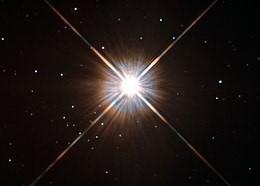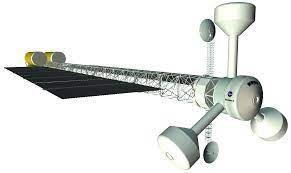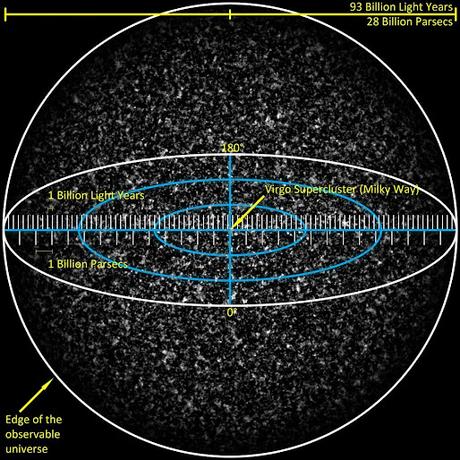
False color image of Proxima Centauri taken from the Hubble Space Telescope 2013.
The bright lines are diffraction spikes.

Image of NASA’s Discovery 2 Fusion Rocket concept
Intriguingly, there is an engine called the Helical engine which was proposed by NASA scientist Dr David Burns in 2019. This engine could, in theory, travel at 98% the speed of light at which relativist time dilation would be apparent, thereby making time pass slower for those traveling compared to those not travelling, such as people on Earth.Travelling to Proxima Centauri using the Helical engine spacecraft would take only seven months whereas for those on Earth the journey would seem to take 4.25 years. However, the Helical engine defies the laws of physics and may never be realised.The star Proxima Centauri is better observed from Earth’s southern hemisphere. However, if we look at the Orion constellation in Earth’s northern hemisphere, we can see that the interstellar distances involved are even greater. When viewing the Orion constellation it is best to look for Orion’s Belt, the three stars that appear to be in a straight line. From Earth, these three stars seem to be close together, but they are far apart.For example, Alnitak, on the left-hand side of Orion’s belt is 800 light years away. Alnilam, in the middle of Orion’s Belt is 1300 light years away. Mintaka, on the right-hand side of Orion’s Belt is 900 light years away. Even traveling at the speed of light it would take hundreds of years to reach these stars and it would require multi-generational space craft and space crews to reach them. The same would apply for Betelgeuse at 550 light years away and Rigel at 860 light years away.Of further difficulty for interstellar space travel is the fact that the universe is expanding. Galaxies are moving further away from each other so that even if we could travel by the speed of light, we would never reach them because they are already too far away. The question as to what the universe is expanding into can be viewed by the analogy of baking a ball of raisin bread dough. As the dough leavens, it expands but the raisins within do not.In essence, the raisins move further away from each other in all three dimensions. From a single raisin’s point of view, local raisins move away slowly, intermediate ones move quicker and the furthest move fastest of all. The bread mimics the fabric of space and the raisins mimic individual galaxies in an expanding universe.However, theories as to what the universe is expanding into include that the universe is expanding into a higher dimension which cannot be seen or comprehended. The universe could also be stuck in a black hole of a bigger universe and from which it cannot escape.
Image of a map of the known universe
It has also been suggested the universe will expand until the galaxies and stars are so far apart there is only darkness left. If the universe expands too quickly it may tear itself apart. The universe may also collapse due to gravitational forces reasserting themselves.It may be that the universe is expanding into itself. That the universe is all there ever has been, all there is and all there ever will be. In essence, the universe is all the matter, radiation, particles and all the emptiness and nothingness of space and time itself.From this viewpoint there are no boundaries or spaces to expand into as the universe does not require them as it is expanding into itself and it will expand into itself for all eternity and infinity. So, the next time someone asks you what the universe is expanding into you can say the universe is expanding into itself. Nothing more, nothing less.To Proxima Centauri
We are travelling, we are
on our way to a new galaxy,
a new dawn, a new day,
past conglomerations of
constellations, old stars
viewed from new perspectives
as we become interstellar
detectives, with curiosity and
resolve we will watch the
new solar systems evolve
before our eyes and record
and collect data for those who
follow us later and follow us
they will to make history and
resolve the mysteries of life
as they unfurl in the
expectations and revelations of
distant stars and different worlds.
Thanks for reading the blog and the poem. Please leave a comment as they are all appreciated.
Dermot Moroney 2024
Email ThisBlogThis!Share to TwitterShare to Facebook
